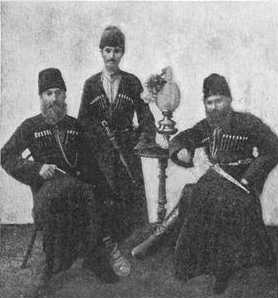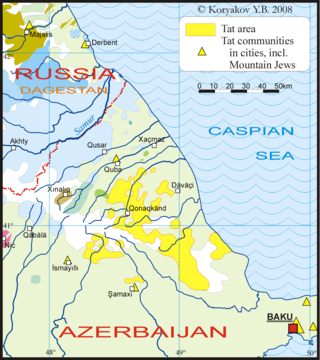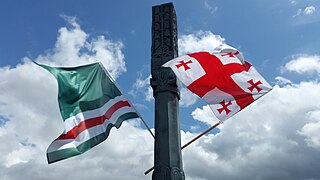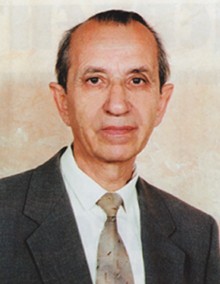Tats in Georgia
Despite the fact that during the Soviet period in the Soviet Union, including Georgia, the ethnic situation was scrupulously described, one ethnic group escaped the field of view of both scientists and state structures. These are lajjs (lakhijs), which were designated (registered) as Azerbaijanis both in the population censuses and in official legal documents proving the identity. Attention should be paid to one more circumstance: the people under such an ethnonym are not attested anywhere. [29] [30] [31]
The Laijs live in Gare Kakheti (Eastern Georgia), in the village of Gombori, Sagarejo region. Although the Laijs were recorded as Azerbaijanis, they did not consider themselves to be such. Along with Laij ethnic consciousness, they have such a basic feature of ethnicity as language. Since this ethnic unit was not known to the general scientific community until today, from now on, such awareness of the scientific community is necessary. The priority of detecting Laijah belongs to the Georgian orientalist (Iranian) scientist Manana Kvachadze, who scientifically studied the Laij language, playing the role of a kind of pioneer in this matter (Kvachadze 1988; 1989; 1998; 2004). The author of the article was familiar from childhood with the original ethnic community of the Laijs, with which he was even linked by certain family ties. What language do the Laijs speak? - In tat language. But it should certainly be emphasized that layjs do not identify themselves with the tatami. And one more interesting circumstance: in the village of Gombori, there is also another group of Muslims who call themselves tat, but speak Azeri rather than Tati. They are also recorded in all documents - both Soviet times and the current ones - as Azerbaijanis. These two ethnic groups of the Islamic faith communicate with each other in Azerbaijani. [32]
According to the materials we obtained, in 2010 there were between 300 and 400 Laijis living in Georgia. For various reasons, it is impossible to determine their exact number. The Laij are people of Iranian / Tato-speaking origin, and the Tats still live in Azerbaijan and Iran (in the Zohra and Talikan regions), as well as in Dagestan. According to linguistic data, Laidzh language is included in the southwestern group of Iranian languages and is one of the dialects of the Tat language. The Laij speech reveals a close genetic link with the Persian and Tajik languages . [33]

Kumyks are a Turkic ethnic group living in Dagestan, Chechnya and North Ossetia. They are the largest Turkic people in the North Caucasus.

Mountain Jews or Caucasus Jews, also known as Juhuro,Juvuro,Juhuri,Juwuri, Juhurim,Kavkazi Jews or Gorsky Jews, are Jews of the eastern and northern Caucasus, mainly Azerbaijan, and various republics in the Russian Federation: Chechnya, Ingushetia, Dagestan, Karachay-Cherkessia, and Kabardino-Balkaria. The Mountain Jews comprise Persian-speaking Jewry along with the Jews of Iran, Afghanistan, and Central Asia. The Mountain Jews are the descendants of Persian Jews from Iran, and fall within the Mizrachi category of Jews. Mountain Jews took shape as a community after Qajar Iran ceded the areas in which they lived to the Russian Empire as part of the Treaty of Gulistan of 1813.

The Tat people or Transcaucasian Persians are an Iranian people presently living within Azerbaijan and Russia. The Tats are part of the indigenous peoples of Iranian origin in the Caucasus.
Burtas were a tribe of uncertain ethnolinguistic affiliation inhabiting the steppe region north of the Caspian Sea in medieval times. They were subject to the Khazars.

Tat, also known as Caucasian Persian, Tat/Tati Persian, or Caucasian Tat, is a Southwestern Iranian language closely related to, but not fully mutually intelligible with Persian and spoken by the Tats in Azerbaijan and Russia. There is also an Iranian language called Judeo-Tat spoken by Mountain Jews.

Judeo-Tat or Juhuri is a Judeo-Persian dialect of the Tat language historically spoken by the Mountain Jews, primarily in Azerbaijan, Dagestan, and today in Israel. It belongs to the southwestern group of the Iranian division of the Indo-European languages with heavy influence from the Hebrew language. In the era of Soviet historiography, the Mountain Jews were mistakenly considered to be related to the Muslim Tats of Azerbaijan. However, they do not share a common linguistic heritage, as the Mountain Jews kept their native language, while the Muslim Tats eventually adopted contemporary Persian. The words Juvuri and Juvuro translate as "Jewish" and "Jews".

The Kists are a Chechen subethnic group in Georgia. They primarily live in the Pankisi Gorge, in the eastern Georgian region of Kakheti, where there are approximately 5,700 Kist people. The modern Kists are not to be confused with the historical term Kists, an ethnonym of Georgian origin, which was used to refer to the Nakh peoples in the Middle Ages.
Azerbaijanis in Russia or Russian Azerbaijanis are people of Azeri descent in Russia. These may be either ethnic Azeris residents in the country or recent immigrants who profess Azeri ancestry.
The Hinukh are a people of Dagestan living in 2 villages: Genukh, Tsuntinsky District - their 'parent village' and Novomonastyrskoe, Kizlyarsky District - where they settled later and live together with Avars and Dargins and also in the cities of Dagestan. They are being assimilated by the Caucasian Avars.

The Mokshas comprise a Mordvinian ethnic group belonging to the Volgaic branch of the Finno-Ugric peoples. They live in Russia, mostly near the Volga and Moksha rivers, a tributary of the Oka River.
The Caspian race was a supposed sub-race of the Caucasian race in the context of a now-outdated model of dividing humanity into different races which was developed originally by Europeans in support of colonialism. The term was used by M. G. Abdushelishvili (1979) as constituting a branch of the Mediterranean race or Irano-Afghan race. In Soviet-era anthropology, the term was used to include Tats and Azerbaijanis.

Yagutil Israelovich Mishiev was a Soviet-Israeli author of books on the history of Derbent, Dagestan, Russia.

The Derbent Khanate was a Caucasian khanate that was established in Afsharid Iran. It corresponded to southern Dagestan and its center was at Derbent.

Simsim was either a historical region or kingdom in the North Caucasus during the Middle Ages, existing in the 14th century. Predominantly localized roughly in eastern Chechnya (Ichkeria), with some also connecting part of Kumyk Plain. Simsim is also localized in both Chechnya and Ingushetia. Its name may have been derived from the Chechen village of Simsir. However, according to folklore, the King Gayur-khan was chosen as the leader of all Chechens by the Mehk-Khel. In its later years it allied itself with the Golden Horde before being destroyed in 1395 by Timurlane, which was recorded in Zafarnama by Nizam al-Din Shami and the Zafarnama by Sharaf ad-Din Ali Yazdi.
Kumykia, or rarely called Kumykistan, is a historical and geographical region located along the Caspian Sea shores, on the Kumyk plateau, in the foothills of Dagestan and along the river Terek. The term Kumykia encompasses territories which are historically and currently populated by the Turkic-speaking Kumyk people. Kumykia was the main "granary of Dagestan". The important trade routes, such as one of the branches of the Great Silk Road, passed via Kumykia.

Judeo-Tat literature is the literature of the Mountain Jews in the Juhuri language.

The Feappii were an Ingush subgroup (society) that mostly inhabited the mountainous Fappi region of Ingushetia in the Caucasus. Historically, they bordered on the west with Dzherakh, on the east with Khamkhins, on the north with Nazranians, and in the south with Gudomakarians. The center of the society was the fortified village (aul) of Erzi or Metskhal.

Armenian-Azerbaijani cultural relations are relations between two ethnic groups in terms of their language and culture.
Boris Vsevolodovich Miller was a Soviet Iranianist scholar, professor at Moscow State University, and doctor of sciences in philology.

Nurēddin Gabertovich Akhriev was a Soviet orientalist who specialized in Arabic studies, and a docent of Moscow State University, where he used to teach for 40 years, being also the first Ingush to do so. One of the founders of Ingush Arabic studies.













